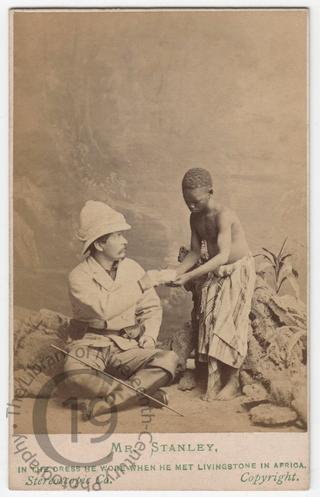
H.M. Stanley and Kalulu
Welsh-born U.S. journalist and explorer H.M. Stanley made four expeditions in Africa. He and Livingstone met at Ujiji in 1871 and explored Lake Tanganyika together. Between 1874 and 1877 Stanley traced the course of the Congo river to the sea, later establishing the Congo Free State (Democratic Republic of Congo) between 1878 and 1884. On his final expedition (1887-1889) he charted much of the interior.
The child seen here with Stanley is Ndugu M’Hali, a slave boy that an Arab trader presented to Stanley during his search for Livingstone. Stanley gave him the name Kalulu, which he believed was the Swahili word for ‘antelope,' because of his bright eyes, slim form, and quick movements. He made Kalulu his personal servant and when he returned to England in 1872, he brought Kalulu with him, enrolling the boy in a Wandsworth school and treating him almost as an adopted son, though Kalulu encountered some prejudice and was not always comfortable in European society. The two were modelled together in wax for Madame Tussaud’s exhibition on Baker Street and Kalulu walked beside the coffin at Livingstone’s funeral in Westminster Abbey. When Stanley travelled to the United States and Paris on a lecture tour, Kalulu went with him. And when in 1874 Stanley returned to Africa, once again Kalulu accompanied him. However, he drowned in 1877 when a canoe was swept over a waterfall on the Lualaba river. Stanley was devastated, later titling the children’s book that he published 'My Kalulu: Prince, King and Slave.'
Photographed in 1872 by the London Stereoscopic and Photographic Company.
Registered at Stationers’ Hall on 15 August 1872. The form describes the image as ‘Photograph of Henry M. Stanley and Kalulu, the former seated, face in profile holding in his hand a cup the latter is presenting to him.’
Code: 127786




